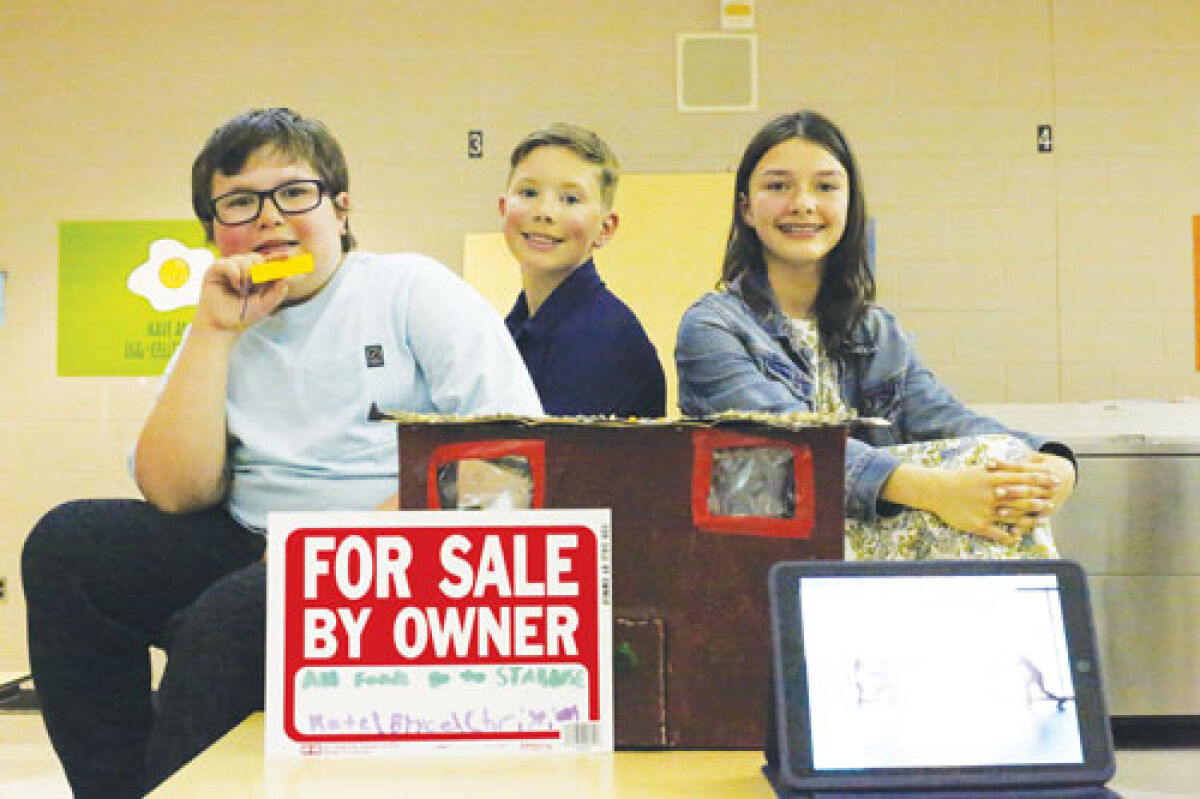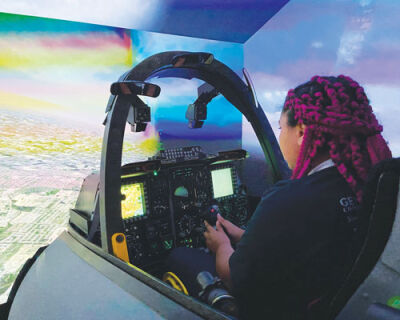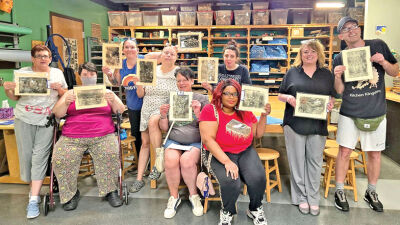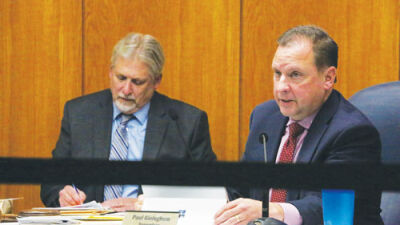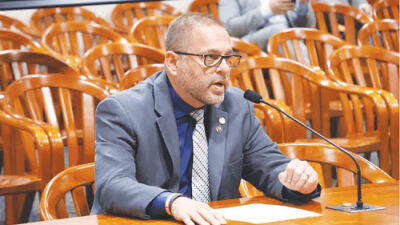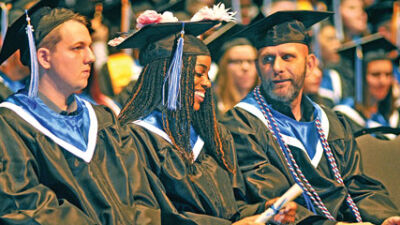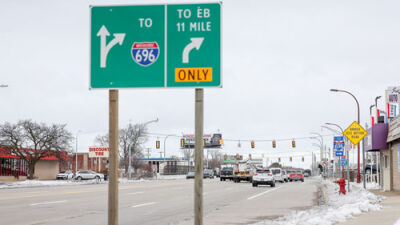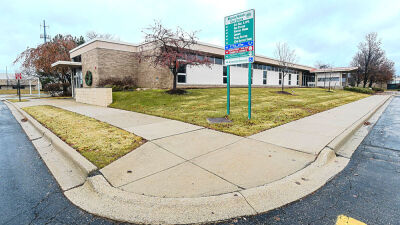CHESTERFIELD TOWNSHIP — In a dimly lit gymnasium inside Francis A. Higgins Elementary School on May 30, fifth grade students fueled by orange juice and sugar cookies celebrated the end of their school year in only the most exciting way possible: simulating the real estate market.
Equipped with slideshows and miniature homes of their own design, the students of Brooke Niskar’s class in the L’Anse Creuse Public Schools district are upselling their peers’ parents on the opportunity to take home their final elementary school project. Yet this is not some elaborate lesson in business studies or anything of the sort, but the final step in a months-long STEM education project turned fundraiser for one of Macomb County’s most notable educational institutions — STARBASE One, located on the premises of Selfridge Air National Guard Base.
“I really like it,” Kate Luplow, a fifth grade student in Niskar’s class, said of the auction fundraiser. “I was nervous for it, but it turned out really well.”
For those lucky enough to have attended it, STARBASE One is the field trip to end all field trips. The first-in-the-country nonprofit education center has combined science, technology, engineering and mathematics education with a hands-on, fun experience for grade schoolers since 1991.
As the name suggests, STARBASE One takes its theme after space exploration. Students get to explore a full-scale recreation of the International Space Station’s Destiny lab module, learn how to program robots by trying to get a rover across a simulated Martian landscape, dine under a re-creation of Alan Shepard’s Freedom 7 capsule at the Milky Way Cafe and try their hand at technologies like 3D printing and computer-aided design software.
A common highlight of a STARBASE One excursion is a chance to take a seat in the facility’s space shuttle nose simulator. Students and teachers alike rave about getting to experience a takeoff from the retired space plane’s cockpit, as well as getting a front-row view of docking with a space station and trying their luck at gliding the shuttle back down to Kennedy Space Center in Florida.
Even with all the space paraphernalia and simulators, STARBASE Director Rick Simms says it is the nonprofit’s team of educators that make the experience as unforgettable as it is.
“They are so dynamic, and they really engage the students,” Simms said. “They’re very attentive to the students because we have all different kinds of kids that come through here. Everybody learns at a different level, and our teaching staff is very adaptable at working with all these different students. To me, that’s really what makes (STARBASE) memorable; that human connection that they’re having with our teaching staff.”
STARBASE funding at risk
Free for schools to visit so long as they provide transportation to and from Selfridge, Simms says a typical STARBASE One engagement takes place over 25 hours, spread across five weeks. But when Niskar’s class visited this winter, the Higgins Elementary fifth graders had their STARBASE adventure cut short after the fourth week. STARBASE One lost its funding.
Though starting at Selfridge with a W. K. Kellogg Foundation grant and volunteer help from base personnel, STARBASE has since become a Department of Defense-funded program with over 80 programs located across the United States and the territories of Puerto Rico and Guam. Despite its nationwide reach and a broad mission to teach more students about STEM-related subjects, Simms says the STARBASE program has fallen off the nonbinding presidential budget recommendations since the Obama administration and has required legislators, namely Michigan’s U.S. Senate delegation of Sen. Gary Peters and the retired Sen. Debbie Stabenow, to get STARBASE back onto the federal budget.
But as Higgins Elementary students were visiting STARBASE One in the early spring, Congress was failing to pass a budget. The budget for the 2025-2026 fiscal year had been delayed since fall 2024 and while stopgap funding was made available through continuing resolutions, the nature of the resolutions means only so much funding is made available. STARBASE was seeking $60 million in the 2025 budget, but the Senate was only willing to give the program $20 million, and the Department of Defense comptroller ran with the $20 million budget number.
“What that meant was, as they kept extending the continuing resolution, for our sites here in Michigan, funding ran out on Feb. 7,” Simms said.
Michigan’s three STARBASE programs ran out of federal funds on Feb. 7, leading to educational staff being furloughed and the indefinite closure of the programs — the first-ever such closure in STARBASE One’s 34 years.
The closing and the loss of the STARBASE One trip struck Niskar’s students hard, but not just because they lost out on their year-defining field trip.
“STARBASE was a great experience for us, and we wanted other kids to have that same experience,” Luplow said. “We really just wanted the future fifth graders to have the same experiences.”
As Niskar recalls, the progression of some curriculum items was not going as quickly as she expected, which meant the big project of building a solar-powered home was at risk of being dropped due to time constraints. However, the 27-year veteran teacher made the decision to adjust the lesson plans to bring the home project, which was originally part of the math curriculum, in as a catch-all STEM project to close out the school year.
“I knew we weren’t going to get to (the solar home math unit) because the end of the school year was coming up, but it looked and sounded so cool that I didn’t want to pass it up,” Niskar said. “I decided to squeeze it in … it really did capture all of the science, technology, engineering, mathematics. My boyfriend actually is an engineer, and I had to ask him for some help at some points.”
The project, which was “extremely involved” in Niskar’s words, saw students group up and try building a scale-sized home that would retain the most energy when exposed to sunlight. Work for the project included testing the heat-absorption of different materials and paints, becoming adept at reading thermometers, developing different kinds of solar collectors, trying out different insulation materials and performing other experiments in order to build the toastiest home possible. Size of the homes mattered as the area of windows was tied to how big the homes were.
“We actually did the measurements of the windows,” fifth grader Sam Sherrill said. “The total dimensions of the windows had to be exactly 1/8th of our house’s total dimensions.”
Students were given leeway in how they chose to design and build their homes. Sherrill said his group built a sunroof into their design.
Niskar planned to have the students present the homes to their fellow students at the end of the year, but then students in the class had an idea. Luplow presented the idea of auctioning the projects off to parents like they were real homes, while peer Noah Kodra jumped in with the idea of donating the raised funds to STARBASE One. The ideas won the support of the students, and Niskar got the word out to parents that an “open house” was scheduled for Friday, May 30. Before the day would arrive, students would also write letters to legislators asking them to support restoring funding to the STARBASE program.
“It was attempting to free STARBASE and try to get other children to experience it,” Kodra said.
And by the time the homes were sold, the parents came through by raising $1,170 for STARBASE.
Along with anticipating how excited the students would be once they found out the final raised amount, Niskar was proud to know the students had taken the initiative to develop and put on the fundraiser.
“For me, that’s more important than anything else,” Niskar said. “I teach the kids the curriculum, but for me it’s more important that they leave my classroom as good human beings. They came in as good human beings, but they got even better with their empathy and their kindness, so for me that was the most important (thing) of all, that they could help others.”
Niskar believes the students’ experiences visiting and fundraising for STARBASE will follow them throughout their educational careers.
“I think that they’re going to remember this more than anything else, quite honestly,” Niskar said. “I think it already has inspired kids to possibly one day become involved with a STEM profession of some sort.”
By the time the fundraiser was held, STARBASE One was already back in operation. Funding for the program was restored in April after Congress passed another continuing resolution, leading to students across the region once again making memories at the Selfridge-based nonprofit.
But Simms has not ceased finding funds to support STARBASE’s survival.
Simms says the goal of STARBASE is to operate as though it is going to continue forever — the program is already booked full for the 2025-26 school year.
“We always look ahead that we’re going to be in full operation, because we do not want to make an assumption … and not schedule people right now,” Simms said. “We want to hit the ground running come the start of the school year and get the classes out here first thing in September.”
Along with running as though there’s no end in sight, Simms and the STARBASE team are working to add more funding streams. A fundraiser at a Buffalo Wild Wings was held in Chesterfield, a golf outing is planned to take place this summer on the SANGB golf course, and the program is working with a grant writer to apply for funding. Several state legislators toured STARBASE One earlier in the year, and Simms said the program is in conversation with state and federal legislators about future support.
“This is a community asset that has been here for 34 years,” Simms said. “To lose that I think would be a shame because all of the knowledge that we have guarded over these years and the delivery of a very high-quality STEM program would go away, and that wouldn’t be something that’s available to the community anymore.”
 Publication select ▼
Publication select ▼